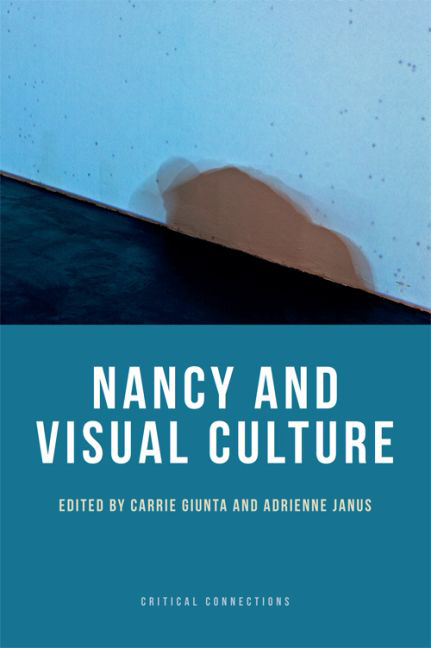Book contents
- Frontmatter
- Contents
- List of illustrations
- Acknowledgements
- Introduction: Jean-Luc Nancy and the Image of Visual Culture
- 1 Cutting and Letting-Be
- 2 Dancing Equality: Image, Imitation and Participation
- 3 A Question of Listening: Nancean Resonance, Return and Relation in Charlie Chaplin
- 4 The Image: Mimesis and Methexis
- 5 On the Threshold: Visual Culture, Invisible Nature
- 6 Pornosophy: Jean-Luc Nancy and the Pornographic Image
- 7 Presentation and Disappearance: Dialogue between Soun-Gui Kim and Jean-Luc Nancy
- 8 Writing in the Place of the Animal
- 9 Together at the Limit: Jean-Luc Nancy, Art and Community
- 10 Turning Around the Written Mark, Opening from a Weight of Thought
- 11 Uncanny Landscapes of Photography: The Partage of Double-Exposure after Jean-Luc Nancy
- Contributors
- Bibliography
- Index
Introduction: Jean-Luc Nancy and the Image of Visual Culture
Published online by Cambridge University Press: 15 September 2017
- Frontmatter
- Contents
- List of illustrations
- Acknowledgements
- Introduction: Jean-Luc Nancy and the Image of Visual Culture
- 1 Cutting and Letting-Be
- 2 Dancing Equality: Image, Imitation and Participation
- 3 A Question of Listening: Nancean Resonance, Return and Relation in Charlie Chaplin
- 4 The Image: Mimesis and Methexis
- 5 On the Threshold: Visual Culture, Invisible Nature
- 6 Pornosophy: Jean-Luc Nancy and the Pornographic Image
- 7 Presentation and Disappearance: Dialogue between Soun-Gui Kim and Jean-Luc Nancy
- 8 Writing in the Place of the Animal
- 9 Together at the Limit: Jean-Luc Nancy, Art and Community
- 10 Turning Around the Written Mark, Opening from a Weight of Thought
- 11 Uncanny Landscapes of Photography: The Partage of Double-Exposure after Jean-Luc Nancy
- Contributors
- Bibliography
- Index
Summary
Whether we are artists, scholars, curators, collectors, casual admirers or a combination of each, our encounter with images is rarely innocent. The proliferation of images in contemporary culture – of ‘old’ and ‘new’ media, of pictures, painting, photography, cinema, television, video and internet – has been accompanied by an extraordinary increase in the number of discourses on what images are or do, what we should or should not do with images, what they mean, represent, what they show or tell, what value they have, and how we should or should not look. If these discourses set the general terms of debate in the study of visual culture, it is a debate often framed at its (post)modernist and historicist poles by the question of whether the proliferation of images in contemporary culture marks a new epoch in the West (the oft-proclaimed hegemony of the image over the book, the visual over the textual), or is merely a culminating moment in a history of ‘visual turns’ as old as the biblical or Byzantine battles between iconoclasts and iconophiles that have emerged throughout Western history at times of competing world views and socio-political uncertainty. In one characteristically provocative response to this question, delivered with a dose of playful self-irony, Jean-Luc Nancy suggests that either way, this doubled proliferation of images in contemporary culture and of contemporary discourses on the image often makes us ‘look cross-eyed’. We have one eye on the image, ‘the other on discourse […] One eye empirical, the other theoretical. One eye on the exhibition wall, the other on the text of the catalogue.’ How then do we resist the strabismus Nancy describes here?
For Nancy, as for this critical appraisal of Nancy's immense contribution to the arts of what we call ‘visual culture’ (a contentious term in itself, and one that Nancy does not use, preferring terms such as ‘the arts’ or ‘the image’), the effort to resist this kind of cross-eyed vision would not mean producing a better, more adequate account of what an image is, an ontological theory from which we might derive a practical ethics or politics that would somehow allow us to ‘see straight’.
- Type
- Chapter
- Information
- Nancy and Visual Culture , pp. 1 - 20Publisher: Edinburgh University PressPrint publication year: 2016



